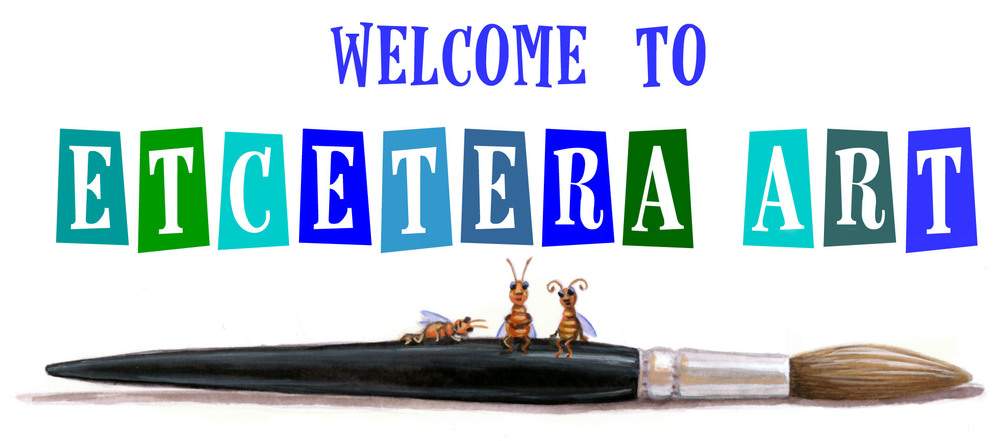Creating Art At Home
The best way to support and encourage your child's interest in art at home is to make art materials accessible and provide a place where your child can work. Click here for inspiring ideas about how to make art accessible at home on one of my favorite websites, Tinkerlab. The author of this article shows how she has organized her dining room as a self-serve creativity zone. Unfortunately most of us don't have that much space. But, as the author notes, "I'm not suggesting that our plan will work for everyone, but the general spirit of it is something that I think we can all stand behind: when children can execute on their own ideas, it builds their confidence and encourages curiosity and a thirst for knowledge."
Whether your child has a shoebox with crayons, scissors, markers and glue and a corner of the kitchen table to work or a dedicated area for art making as shown in the article, the most important thing is the love and encouragement you show in your child's creations and the gift of time and space to work on their ideas.
Basic Materials:
- Crayons (Crayola crayons are the best--I've found most other brands are too waxy)
- Pencils & erasers
- Pens
- Markers
- Colored Pencils
- Watercolor (I use Prang watercolors in the art room)
- Paint brushes
- White paper, lots of paper!
- Construction paper
- Scissors
- White glue & glue sticks
- Masking tape
Fun Extras to try:
- Watercolor pencils
- Polymer Clay (Fimo or Sculpey)
- Yarn
- Hole punch
- Stapler
- Oil Pastels (Crayola brand is my favorite here too!)
- Tempera paint
- Fabric scraps
- Origami paper
- Various fun colored pens
- Odds & Ends Box: Children love exploring materials--my experience is that if you give them the materials and invite them to play with it, they will know what to do! Create an Odds & Ends Box--put anything that looks interesting in it . . . such as ribbons, bottle caps, corks, string, paper, fabric, foil, buttons, cardboard, anything shiny, rocks, feathers, twigs & leaves, egg cartons, toothpicks, straws . . . well, the list is infinite!
Masonite Board: Art can be messy--what to do if you don't have a place for mess? I personally like to use masonite boards--I have a couple of 24" x 24" for use on my dining room table when I need more room to draw and paint. I also have masonite boards for students cut to 12" x 18" for use in the art room for drawing on the floor or taking outside.
Paint Brushes: there are many kinds of paint brushes out there! Which ones for what?
- In general, round brushes with soft bristles are used for watercolor painting--see photo below. I recommend beginning with a size 4 and size 10.
- Brights are great for tempera painting--the bristles are stiff and the tip flat for scooping up and brushing thick paint. See photo below. For beginning, try a size 12, 14 or 16.
- By the way, don't let these brush suggestions stop you from experimenting! I've seen some fabulous watercolors created with a bright and vice versa!
Round Watercolor Brushes
Bright: great for tempera painting
Paper: My favorite paper for sketching and drawing is plain old copy paper! It's inexpensive and has a great, crisp drawing surface. Drawing and painting pads come in various sizes. If you can swing it, buy a small, medium and large pad--and don't overlook the really large 18" x 24" pad. Those big sheets of paper really let you stretch out with a big drawing and kids love the large size!
Drawing Pencils: At the art store there are dozens of pencils . . . most range from 2H - 9H and 2B - 9B. H pencils are hard and B pencils are soft. In the art room, in addition to the regular #2 pencils, students use 6B drawing pencils. 6B is easy to smear with your fingers and creates lovely light, medium and dark shadings.
Drawing Books: the students love the How to Draw books in the art room. Consider buying a couple for home. I have found them in various places such as Michaels, Barnes & Noble, Amazon and occasionally at CVS or RiteAid.
My favorite places for art supplies:
- Michael's Stores: 15100 Hesperian Blvd. San Leandro or 3991 Hollis St. Emeryville
- Blick Art: 5301 Broadway, Oakland
- Artist and Craftsman Supply: 2573 Shattuck Ave. Berkeley
A few fun websites:
Some of these sites are written for preschool children in mind, but I think that many of the ideas, suggestions and projects are excellent for older children too.
Books on Creating Art with Children:
- The Artful Parent: this book is at the main branch of the public library--I highly recommend you check it out!
- Art Lab Books: my favorites are Drawing for Mixed Media Artists, Print & Stamp, Art Lab for Kids, Art Lab for Little Kids
- Klutz Books: my favorite that I used with my own son is The Incredible Clay Book






